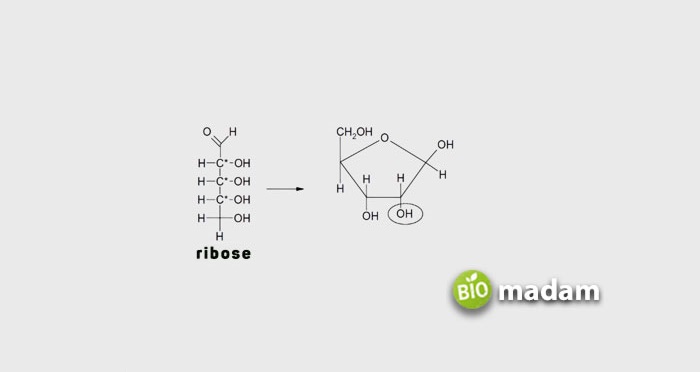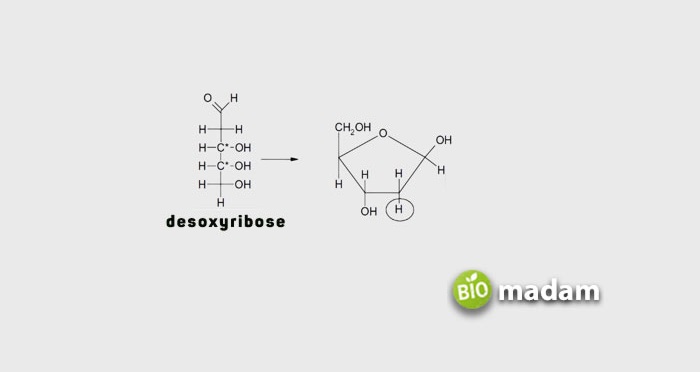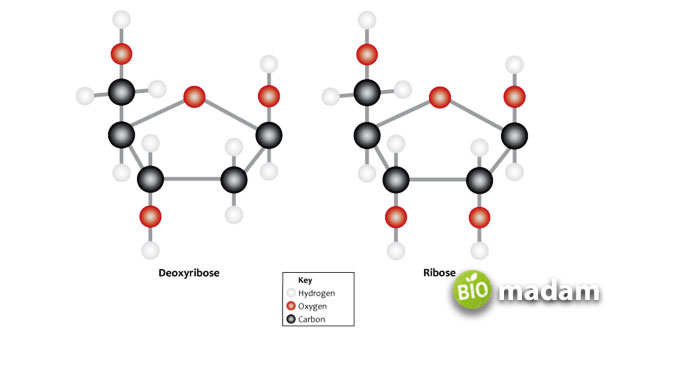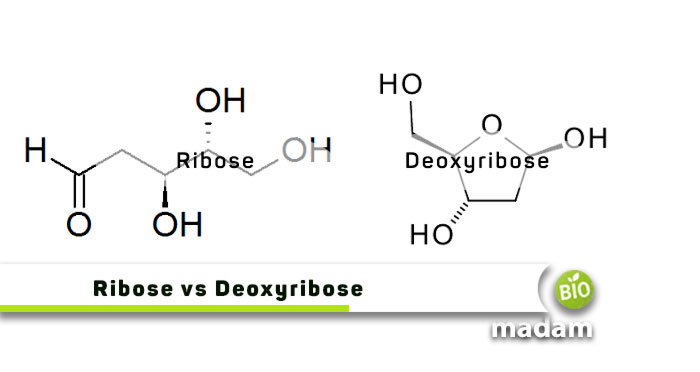DNA in the nucleus and protein-synthesizing RNAs are essential nucleic acids for the human body. Nucleic acids like RNA and DNA are made up of nucleotides. Ribose and deoxyribose are the essential components of nucleotides in nucleic acids. They are monosaccharide sugars formed from aldopentoses. The main difference between ribose and deoxyribose is their sugar structure. Ribose is a pentose sugar, while deoxyribose has a hexose structure.
Keep reading to learn all the differences between ribose and deoxyribose. We will start by comparing the ribose and deoxyribose through a table.
Comparison Table
| Characteristics | Ribose | Deoxyribose |
| Discovery Year | 1891 | 1929 |
| Discoverer | Emil Fischer | Phoebus Levene |
| Other Names | D-ribose & L-ribose | 2-deoxy-D-erythro-pentose |
| Structure | Hydroxyl group present | Oxygen atom is absent |
| Chemical Formula | C5H10O5 | C5H10O4 |
| Molecular Mass | 150.13 g/mol | 134.13 g/mol |
| Resulting Nucleic Acid | RNA | DNA |
| Repulsion | Present | Absent |
| Molecule Stability | Flexible | Stable |
What is Ribose?
Ribose is a 5-carbon (pentose) sugar with the molecular formula C5H10O5. Emil Fischer discovered it in 1891. It has a hydroxyl group in carbon 2, leading to an electrostatic negative charge on the molecule. The negative charge results in repulsion and the uncoiling of the RNA molecule.
The pentose structure has two enantiomers: L-ribose and D-ribose. D-ribose is found widely naturally, while L-ribose does not occur in nature. Ribose is the basic component of ribonucleotides that make up ribonucleic acid. Ribonucleotides are essential to encode, decode, and regulate gene expression. The phosphorylated products of ribose, like NADH and ATP, contribute to various cellular processes like photosynthesis and cellular respiration.

What is Deoxyribose?
The name deoxyribose comes from the loss of oxygen in the five-carbon pentose sugar. It is a pentose monosaccharide with the chemical formula C5H10O4. Phoebus Levene discovered deoxyribose in 1929. It is the main component of deoxyribose nucleic acid (DNA).
Deoxyribose has two enantiomers: D-2-deoxyribose and L-2-deoxyribose. D-2-deoxyribose is abundant in nature, whereas L-2-deoxyribose rarely occurs. The carbon 2 of the five-carbon sugar does not have an oxygen atom like ribose sugar. Deoxyribose does not have the oxygen atom in position 2, so it does not repel the negatively charged phosphate. Eventually, it forms the characteristic double-stranded DNA structure.

Similarities Between Ribose and Deoxyribose
- Ribose and deoxyribose are simple sugars (monosaccharides).
- Both of them are formed from aldopentoses.
- They contribute to the formation of nucleic acids; thus, the 2 types of nucleic acids found in living organisms are ribose and deoxyribose.
Chemical Structure of Ribose and Deoxyribose
It is very simple to identify the chemical structures of ribose and deoxyribose sugars. The illustration is given below:

Differences Between Ribose and Deoxyribose
Ribose and deoxyribose sugars differ by the following:
Definition
Ribose
Ribose is a monosaccharide pentose sugar with an aldehyde functional group at one end.
Deoxyribose
On the other hand, deoxyribose is a 2-deoxyribose monosaccharide with one less oxygen than ribose sugar.
Discovery
Ribose
Emil Fischer discovered the ribose structure in 1891.
Deoxyribose
On the other hand, Phoebus Levene discovered deoxyribose in 1929.
Other Names
Ribose
Ribose is also known by the name D-ribose as it is its broadly existing enantiomer in nature. However, L-ribose also occurs.
Deoxyribose
Whereas on the contrary, 2-deoxy-D-erythro-pentose is the other name for deoxyribose.
Structure
Ribose
Ribose is a 5-carbon monosaccharide with a hydroxyl group on the carbon 2 of the sugar ring.
Deoxyribose
Alternatively, deoxyribose is a pentose sugar without the oxygen atom on carbon 2 of the sugar ring.
Chemical Formula
Ribose
The chemical formula of ribose is C5H10O5.
Deoxyribose
At the same time, deoxyribose is indicated by the chemical formula C5H10O4.
Molecular Mass
Ribose
Ribose has a molecular mass of 150.13 g/mol.
Deoxyribose
While the molecular mass of deoxyribose is 134.13 g/mol.
Resulting Nucleic Acid
Ribose
Ribose aids in the formation of ribonucleic acids or RNA that performs multiple functions for the body.
Deoxyribose
On the contrary, deoxyribose is a component of DNA molecules that is different for eukaryotes and prokaryotes.
Effect on Nucleotide Structure
Ribose
The RNA molecule is more flexible because of the repulsion between ribose and phosphate groups due to negative charge.
Deoxyribose
Due to the absence of the negative charge, the DNA twists to form a stable double helix structure.
Relationship Between Ribose and Deoxyribose
Ribose and deoxyribose are the building blocks of nucleic acids like RNA and DNA. Despite their role in the production of different nucleic acids, they have a similar basic structure. Ribose and deoxyribose are pentose and aldose sugars, respectively. They are reducing sugars belonging to monosaccharides. Besides pentose and aldose, ketose are also essential monosaccharides.
The Bottom Line
At the end, which statement accurately summarizes the difference between ribose and deoxyribose? Both are critical molecules as they contribute to the formation of RNA and DNA. RNA is essential for producing proteins, leading to different protein structures in the body. On the other hand, DNA is an essential part of chromosomes and chromatin and plays an integral role in mitosis and meiosis. They are both pentose sugars belonging to the monosaccharides category. The negative charge in the ribose molecule makes it flexible, while deoxyribose forms a stable helical DNA.
FAQs
What is the main difference between the ribose in RNA and deoxyribose in DNA?
DNA contains deoxyribose compared to ribose in the RNA molecule. As the name indicates, deoxyribose lacks one oxygen atom.
What is the function of deoxyribose and ribose?
Ribose and deoxyribose are the building blocks of important materials in the body. They contribute to the production of RNA and DNA. RNA plays a significant role in protein synthesis, while DNA is integral to chromosomes, genes, euchromatin, and heterochromatin.
What is the main function of ribose?
The body uses ribose to produce ATPs that contribute to various cellular and physiological functions. Exercise may lead to the depletion of ribose molecules that get replenished within minutes.

Hello, I would like to introduce myself to you! I am Chelsea Rogers, an experienced blog writer for science articles, holding an MPhil degree. My enthusiasm to grab the best knowledge, let it relate to botany, zoology, or any other science branch. Read my articles & let me wait for your words s in the comment section.

